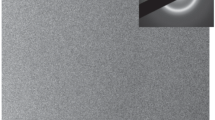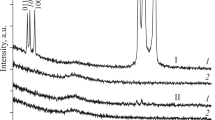Abstract
The development of advanced technologies includes the development of new materials, which include composite amorphous nanocrystalline materials characterized by a unique combination of magnetic and mechanical properties (the latter include high strength, hardness, and wear resistance and others). However, the potential for using such materials is limited, since they are relatively quickly embrittled (lose their plasticity) even at room temperature. The properties of plasticity cannot be restored by heat treatment of the amorphous phase. It is found that properties of plasticity can be restored using thermal cycling in the interval between the temperature of liquid nitrogen (77 K) and room temperature (295 K). This process of treatment is called rejuvenation; it turns out to be acceptable only for bulk samples obtained in the form of rods. It is not suitable for samples in the form of ribbons with a thickness of 20–50 μm (the vast majority of amorphous alloys are obtained in this form). A modernized technology for treating such samples of amorphous alloys and partially crystalline alloys using cryogenic thermocycling is presented. This technology allows one to restore the amorphous structure and plasticity of thin ribbons. X-ray diffraction patterns of ribbon samples of alloy Al87Ni8Gd5 pre-annealed at a temperature of 170°C with the fraction of the nanocrystalline phase not exceeding 10% before and after several successive cooling/heating cycles show that the amorphous structure of the initial sample can be completely restored by increasing the number of cycles to two hundred.




Similar content being viewed by others
REFERENCES
Chunchu, V. and Markandeyulu, G., Magnetoimpedance studies in as quenched Fe73.5Si13.5B8CuV3–xAlNbx nanocrystalline ribbons, Appl. Phys., 2013, vol. 113, art. ID 17A321. https://doi.org/10.1063/1.4795800
Guo, W. and Kato, H., Development and microstructure optimization of Mg-based metallic glass matrix composites with in situ B2-NiTi dispersoids, Mater. Des., 2015, vol. 83, pp. 238–248. https://doi.org/10.1016/j.matdes.2015.06.033
Eckert, J., Calin, M., Yu, P., et al., Al-based alloys containing amorphous and nanostructured phases, Rev. Adv. Mater. Sci., 2008, vol. 18, p. 169.
Aronin, A., Abrosimova, G., Matveev, D., and Rybchenko, O., Structure and properties of nanocrystalline alloys prepared by high pressure torsion, Rev. Adv. Mater. Sci., 2010, vol. 25, p. 52.
Gunderov, D., Kuranova, N., Lukyanov, A., et al., Structure and properties of ageing and nonageing alloys Ti49.4Ni50.6 and Ti50.2Ni49.8 subjected to high pressure torsion, Rev. Adv. Mater. Sci., 2010, vol. 25, pp. 58–66.
Zheng, Q., Design strategies to improve the plasticity of bulk metallic glasses, Rev. Adv. Mater. Sci., 2015, vol. 40, pp. 1–14.
Xiang, R., Zhou, Sh., Dong, B., et al., Effect of Co addition on crystallization and magnetic properties of FeSiBPC alloys, Progr. Nat. Sci. Mater. Int., 2014, vol. 24, p. 649.
Meng, F., Tsuchija, K., and Yokoyama, Y., Reversible transition of deformation mode by structural rejuvenation and relaxation in bulk metallic glass, Appl. Phys. Lett., 2012, vol. 101, pp. 121914. https://doi.org/10.1063/1.4753998
Tong, Y., Iwashita, T., Dmowski, W., et al., Structural rejuvenation in bulk metallic glasses, Acta Mater., 2015, vol. 86, pp. 240–246. .https://doi.org/10.1016/j.actamat.2014.12.020
Dmowski, W., Yokoyama, Y., Chuang, A., et al., Structural rejuvenation in a bulk metallic glass induced by severe plastic deformation, Acta Mater., 2010, vol. 58, pp. 429–438. https://doi.org/10.1016/j.actamat.2009.09.021
Guo, W., Yamada, R., and Saida, J., Rejuvenation and plasticization of metallic glass by deep cryogenic cycling, Intermetallics, 2018, vol. 93, pp. 141–147. https://doi.org/10.1016/j.intermet.2017.11.015
Tong, Y., Dmowski, W., Bei, H., et al., Mechanical rejuvenation in bulk metallic glass induced by thermo-mechanical creep, Acta Mater., 2018, vol. 148, pp. 384–390. doi . 2018.02.019https://doi.org/10.1016/j.actamat
Abrosimova, G., Volkov, N., Tran Van Tuan, et al., Cryogenic rejuvenation of Al-based amorphous-nanocrystalline alloys, Mater. Lett., 2019, vol. 240, pp. 150–152. https://doi.org/10.1016/j.matlet.2018.12.131
Abrosimova, G.E. and Shmytko, I.M., The use of single-crystal cuvettes with the properties of an optical shutter in X-ray diffractometers, Zavod. Lab., Diagn. Mater., 2018, vol. 84, no. 6, pp. 34–37. https://doi.org/10.26896/1028-6861-2018-84-6-34-37
Abrosimova, G. and Aronin, A., Effect of the concentration of a rare-earth component on the parameters of the nanocrystalline structure in aluminum-based alloys, Phys. Solid State, 2009, vol. 51, pp. 1765–1771. https://doi.org/10.1134/S1063783409090017
Abrosimova, G., Aronin, A., and Budchenko, A., Amorphous phase decomposition in Al–Ni–RE alloys, Mater. Lett., 2015, vol. 2139, pp. 194–196. https://doi.org/10.1016/j.matlet.2014.10.076
Funding
This work was carried out as part of the state assignment of the Institute of Solid State Physics of the Russian Academy of Sciences.
Author information
Authors and Affiliations
Corresponding author
Ethics declarations
The authors declare that they have no conflicts of interest.
Additional information
Translated by I. Obrezanova
Rights and permissions
About this article
Cite this article
Abrosimova, G.E., Volkov, N.A. & Aronin, A.S. Restoration of the Structure of Amorphous Alloys and Partially Crystalline Alloys Using Cryogenic Thermocycling. Inorg Mater 56, 1467–1470 (2020). https://doi.org/10.1134/S0020168520150029
Received:
Revised:
Accepted:
Published:
Issue Date:
DOI: https://doi.org/10.1134/S0020168520150029




